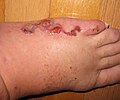Cutaneous larva migrans

Editor-In-Chief: Prab R Tumpati, MD
Obesity, Sleep & Internal medicine
Founder, WikiMD Wellnesspedia &
W8MD medical weight loss NYC and sleep center NYC
| Cutaneous larva migrans | |
|---|---|
 | |
| Synonyms | Creeping eruption, sandworm disease, plumber's itch |
| Pronounce | N/A |
| Specialty | N/A |
| Symptoms | Itchy, red, winding rash |
| Complications | Secondary infection |
| Onset | 1-5 days after exposure |
| Duration | Weeks to months |
| Types | N/A |
| Causes | Ancylostoma braziliense, Ancylostoma caninum |
| Risks | Walking barefoot on contaminated soil |
| Diagnosis | Clinical evaluation |
| Differential diagnosis | Tinea corporis, Scabies, Contact dermatitis |
| Prevention | Wearing shoes, avoiding contaminated areas |
| Treatment | Albendazole, Ivermectin |
| Medication | N/A |
| Prognosis | N/A |
| Frequency | Common in tropical and subtropical regions |
| Deaths | N/A |
Cutaneous larva migrans is a skin disease in humans, caused by the larvae of various nematode parasites of the hookworm family (Ancylostomatidae). The most common species causing this disease in the Americas are Ancylostoma braziliense and Ancylostoma caninum, both of which are found in the feces of dogs and cats.
Causes[edit]
Cutaneous larva migrans is caused by infection with hookworm larvae in contaminated soil. The larvae are able to penetrate the skin and migrate under the skin's surface, causing intense itching and a characteristic serpiginous track marking.
Symptoms[edit]
The main symptom of cutaneous larva migrans is intense itching, which is caused by the migration of the larvae under the skin. The larvae leave a characteristic serpiginous track, which is a visible red line that moves as the larvae migrate. Other symptoms may include a rash, blisters, and swelling.
Diagnosis[edit]
The diagnosis of cutaneous larva migrans is primarily based on the characteristic clinical presentation. The history of exposure to a potentially contaminated environment, such as a beach or a sandbox, is also important. Laboratory tests are not usually necessary, but a skin biopsy may be performed in some cases.
Treatment[edit]
The treatment of cutaneous larva migrans includes oral medications such as albendazole and ivermectin. Topical treatments, such as thiabendazole, can also be used. In some cases, the infection may resolve on its own without treatment.
Prevention[edit]
Prevention of cutaneous larva migrans involves avoiding contact with potentially contaminated soil, especially in areas where dogs and cats are present. Wearing protective footwear in these areas can also help prevent infection.
Gallery[edit]
-
Cutaneous larva migrans
-
Cutaneous larva migrans
See also[edit]
Ad. Transform your life with W8MD's Budget GLP-1 injections from $75


W8MD offers a medical weight loss program to lose weight in Philadelphia. Our physician-supervised medical weight loss provides:
- Weight loss injections in NYC (generic and brand names):
- Zepbound / Mounjaro, Wegovy / Ozempic, Saxenda
- Most insurances accepted or discounted self-pay rates. We will obtain insurance prior authorizations if needed.
- Generic GLP1 weight loss injections from $75 for the starting dose.
- Also offer prescription weight loss medications including Phentermine, Qsymia, Diethylpropion, Contrave etc.
NYC weight loss doctor appointmentsNYC weight loss doctor appointments
Start your NYC weight loss journey today at our NYC medical weight loss and Philadelphia medical weight loss clinics.
- Call 718-946-5500 to lose weight in NYC or for medical weight loss in Philadelphia 215-676-2334.
- Tags:NYC medical weight loss, Philadelphia lose weight Zepbound NYC, Budget GLP1 weight loss injections, Wegovy Philadelphia, Wegovy NYC, Philadelphia medical weight loss, Brookly weight loss and Wegovy NYC
|
WikiMD's Wellness Encyclopedia |
| Let Food Be Thy Medicine Medicine Thy Food - Hippocrates |
Medical Disclaimer: WikiMD is not a substitute for professional medical advice. The information on WikiMD is provided as an information resource only, may be incorrect, outdated or misleading, and is not to be used or relied on for any diagnostic or treatment purposes. Please consult your health care provider before making any healthcare decisions or for guidance about a specific medical condition. WikiMD expressly disclaims responsibility, and shall have no liability, for any damages, loss, injury, or liability whatsoever suffered as a result of your reliance on the information contained in this site. By visiting this site you agree to the foregoing terms and conditions, which may from time to time be changed or supplemented by WikiMD. If you do not agree to the foregoing terms and conditions, you should not enter or use this site. See full disclaimer.
Credits:Most images are courtesy of Wikimedia commons, and templates, categories Wikipedia, licensed under CC BY SA or similar.
Translate this page: - East Asian
中文,
日本,
한국어,
South Asian
हिन्दी,
தமிழ்,
తెలుగు,
Urdu,
ಕನ್ನಡ,
Southeast Asian
Indonesian,
Vietnamese,
Thai,
မြန်မာဘာသာ,
বাংলা
European
español,
Deutsch,
français,
Greek,
português do Brasil,
polski,
română,
русский,
Nederlands,
norsk,
svenska,
suomi,
Italian
Middle Eastern & African
عربى,
Turkish,
Persian,
Hebrew,
Afrikaans,
isiZulu,
Kiswahili,
Other
Bulgarian,
Hungarian,
Czech,
Swedish,
മലയാളം,
मराठी,
ਪੰਜਾਬੀ,
ગુજરાતી,
Portuguese,
Ukrainian




